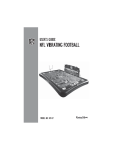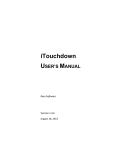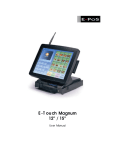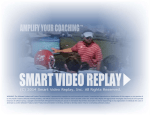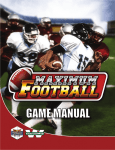Download Excalibur NF-06 User`s guide
Transcript
USER’S GUIDE: GAME TIME ELECTRONIC FOOTBALL MODEL NO.: NF-06 C ongratulations on your purchase of NFL Game Time Electronic Football! This is perhaps the most challenging, exciting NFL strategy game ever! Players battle head-to-head for glory on the gridiron. Read your opponent, choose your play, and direct your blockers—your cunning and a little luck will determine who will emerge victorious! Features: • • • • • • Authentic NFL field detailing Unique Play Rotor adds the element of fate Matrix LCD tracks the game Realistic sound and announcer voice Over 1,000 play combinations Control every phase of the game—offense, defense and special teams Game Clock SOUND LCD Screen Play Rotor Play Chart TIME SNAP Play Dial Down Display Special Teams Dial Blocking Dial ON/OFF Switch BLITZ Football Game Piece “Football is a game played with arms, legs and shoulders—but mostly from the neck up.” —Knute Rockne 2 INTRODUCTION GAME BOARD NFL Game Time Electronic Football is a 2player strategy game which tests your ability to choose the right plays, direct blockers, read your opponent and react to their strategy on offense, defense and special teams. Choose between three play types (Run, Short Pass, Long Pass), four blocking schemes (End, Center, Guard, Tackle), and several special teams plays. On offense, you’re looking for the play that fits the game situation and will catch your opponent off guard. On defense, you’ll try to predict your opponent’s play calls to minimize their offensive production, and to force big defensive plays and turnovers. LCD SCREEN The LCD keeps track of all aspects of the game. It is the scoreboard; it keeps track of the distance to go before a first down; it shows your position on the field; and it displays the results of your play. An arrow on the LCD shows which side of the 50-yard line the ball is on. The LCD will also provide some game instructions, when necessary. Home Team Score Football is more than just a game of strategy—it’s also a game of execution, and occasionally luck. Even the best coach can never fully control what happens on the field. That’s why the unique play rotor in the center of the board will randomize your results. That’s the way the ball bounces! Away Team Score Ball Location Arrow Ball Location Distance to Go BATTERY INFORMATION NFL Game Time Electronic Football requires three (3) AA batteries, not included. To install batteries, turn the unit over and place it face down on a cloth or other soft surface. Use a small, Phillips-head screwdriver to remove the screw from the battery cover. Pull the tab down and remove the cover. Play Result Message Insert three (3) AA alkaline batteries in the battery compartment, making sure to match the polarity (+ and -) marked inside the compartment. Replace the battery cover and secure the screw. GAME CLOCK The Game Clock counts down the time remaining in each quarter using an arrangement of 15 LEDs. The last two LEDs are red, letting you know that time is winding down. Beneath the circular clock is a row of four LEDs that indicate the game quarter. In the event of an overtime, the LEDs will reset so that the first overtime period is represented by the first LED, and so on. See page 9 for additional battery information. 3 Note: the LEDs on the Game Clock will always count down from the final LED to the first, regardless of the quarter length you choose. If you set the clock for 15-minute quarters, each LED will represent 1 minute. If you set the clock for a shorter quarter, each LED will represent a smaller time increment. BUTTONS AND THEIR FUNCTIONS SOUND BUTTON The SOUND button allows you to change the volume of the voice and sound effects at any time during the game. There are three sound levels: Low, High, Off. When the game is first turned on, the volume will be set at Low. Press SOUND to increase the volume to High. Press SOUND again to turn the volume Off. TIME BUTTON Before the opening kickoff, press the TIME button to change the length of the quarters. The quarter length is set to 15 minutes by default. Press TIME once to change to 10minute quarters. Press TIME again to change to 5-minute quarters. Press TIME again to select 3-minute quarters, which is the shortest quarter length in NFL Game Time. DOWN DISPLAY Four LEDs are positioned just below the Play Clock. These keep track of what Down the offense is about to run. The fourth LED is red, letting you know that it is a critical 4th down play. During the game, press TIME to stop the Play Clock. Press again to restart the clock and resume play. GAME DIALS AND BUTTONS PLAY CHART Each side of the board is equipped with a series of Game Dials and Buttons. While on offense, use these dials to choose the play you think will be most successful given the game situation. On defense, try to guess your opponent’s play call, setting your Game Dials to defend against the offense’s attack. The Play Chart on the right side of the game board shows the play calls that were chosen by the Home team and the Away team. These LEDs will light up immediately following the play, so you can see what play and blocking scheme your opponent just ran. PLAY DIAL The Play Dial has three positions: Run, Short Pass, Long Pass. A typical Run will gain about 5 yards; a Short Pass will gain about 10 yards, and a Long Pass will gain 20 yards. However, your play’s success is determined by a combination of the offensive play, defensive play, offensive blocking scheme, defensive blocking scheme, and the Play Rotor result. 4 SPECIAL TEAMS DIAL PLAY ROTOR The Special Teams Dial is used in any kicking situation. It has five positions: Off, Kickoff, Onside, Punt, Field Goal. The Special Teams Dial must be in the Off position in order to run a normal play. Football is a game of strategy, but it’s also a game of inches, close calls, luck, spectacular plays and missed opportunities. The Play Rotor is a wheel of fate—it affects every play of every game. BLOCKING DIAL The Play Rotor has five positions: A, B, C, D, E. Each of these positions combines with the play calls and blocking schemes to determine the final play result. SNAP starts the Play Rotor and BLITZ stops it, but that’s about all the control you can count on. The Blocking Dial directs your offensive and defensive line. It has four positions: End, Center, Guard, Tackle. If the defense chooses the same blocking scheme as the offense, the offense’s production on that play will be severely limited. If the defense chooses a blocking scheme that is similar to the offense’s (End vs. Center, Guard vs. Tackle), the offense’s production will be affected minimally. If the defense chooses poorly (End vs. Tackle, Guard vs. End), the offense will have a much more successful play result. Every play is different, but in general, A is neutral and does not favor either side. B slightly favors the offense and C slightly favors the defense. D strongly favors the offense, while E strongly favors the defense. If the play rotor lands on E, there’s a good chance that the ball is changing hands. SNAP BUTTON The SNAP button begins the play by starting the Play Rotor. It may only be pressed while on offense, or as the kicking team. GETTING STARTED BLITZ BUTTON Turn the game on by turning the ON/OFF switch to the ON position. Before starting your game, choose the length of your game by pressing the TIME button repeatedly. LEDs on the play clock will light up, letting you choose between 15-minute, 10-minute, 5minute and 3-minute quarters. You will not be able to change the quarter length after the opening kickoff. The BLITZ button stops the Play Rotor and signals the end of the play. The play result will be displayed on the LCD immediately after the Play Rotor stops. CALLING THE PLAY HOME AND AWAY The defense can adjust its play calls until the BLITZ button is pressed. The offense’s play is locked in as soon as the SNAP button is pressed. Try to use this brief delay to read the offensive coach’s demeanor—you may turn this into a critical advantage. Players should flip a coin to determine Home and Away. One player will flip the coin. If it lands on heads, that player will be the Home team. If it lands on tails, that player will be Away. The Home team kicks off to start the game. The Away team will kick off to start the second half. 5 the quarters you decided on at the beginning of the game. THE GAME BREAKDOWN Football games are divided into four quarters, with a special break in the action at halftime. You’re probably familiar with how football works, but here’s how it works in NFL Game Time Electronic Football: The first team to score wins. If neither team is able to score by the end of the overtime period, a second overtime period is played. This is continued until one team is able to score and win the game. 1ST QUARTER: OVERTIME RULES Play begins with the opening Coin Toss and the ensuing Opening Kickoff. The overtime period is played following the same rules as the regulation game. The Home team will kick off to begin overtime. 2ND QUARTER: If a second overtime period is required, the Away team will kick off to begin the period. Teams will continue alternating the overtime kickoff until one team wins the game. The team that has the ball retains possession and continues its drive. Remember, the 2nd half will start with a new kickoff, so toward the end of the 2nd quarter, the team with the ball should try to get in position to score before halftime. SETTING AND RUNNING PLAYS HALFTIME: KICKOFFS Halftime pauses the game, and will last until teams set the Special Teams dials to Kickoff and the SNAP button is pressed. Standard Kickoffs • Kicking team selects “Kickoff” on middle dial. • Receiving team selects “Kickoff” on middle dial. • Both Kicking and Receiving team choose a blocking scheme on right dial. • Kicking team presses SNAP button to start the rotor. • Receiving team presses BLITZ to stop the rotor. • Receiving team takes over on Offense. 3RD QUARTER: The 2nd Half begins with a kickoff. The Away team kicks off to start the 3rd quarter. 4TH QUARTER: This is the final quarter of regulation, so pay attention to the score and plan your play accordingly. If you are ahead, you may choose to control the ball by calling Run plays. If you’re behind, you should take some risks and mix Short and Long Passes. NOTE: The kickoff cannot occur until the Kicking team chooses “Kickoff” on the dial. If the Receiving team fails to select “Kickoff” on the dial, the play continues, but the result of the play is a touchback, and the Receiving team will take over on offense on their own 20-yard line. END OF THE GAME At the end of 4 quarters, the team with the most points is declared the winner. If the teams are tied, a sudden-death overtime period must be played. The length of the overtime period will be equal to the length of 6 Onside Kickoffs The play result will be either: Run Yardage will be applied to the ball location, and down and distance will be adjusted. The yardage may be negative. Teams may attempt an onside kick in any kickoff situation. Blocking schemes do not affect the outcome of the play. Onside vs. Onside Pass Complete Yardage will be applied to the ball location, and down and distance will be adjusted. The yardage may be negative. If the Kicking Team chooses Onside Kick and the Receiving team also chooses Onside Kick, the success rate is very low. Incomplete Pass 0 yards gained on the play, and loss of down (2nd and 4 becomes 3rd and 4). • If successful, the Kicking team recovers the ball at the 50-yard line. • If unsuccessful, the Receiving team recovers the ball on the 50-yard line. Sack Negative yardage will be applied to the ball location, and down and distance will be adjusted. Onside vs. Kickoff (or any other defense) If the Kicking team selects Onside Kick and the Receiving team chooses any other defense, the success rate is much higher. Onside kicks vs. any other defense are successful about twice as often as when the Receiving team correctly looks for the Onside kick, but are still successful less than 50% of the time. Interception Defense takes possession. The ball location will be changed where necessary. Example: • 2nd & 5, ball on the Defense’s 40-yard line • Play result: Interception, -10 yards • Next play: 1st & 10, possession changed, ball on 50-yard line • If successful, the Kicking team recovers the ball at the 50-yard line. • If unsuccessful, the Receiving team recovers the ball on the 50-yard line. OFFENSE VS. DEFENSE • Fumble Defense takes possession. The ball location will be changed where necessary. To run a standard play (not Special Teams), your Special Teams dial must be set to OFF. If either team has the Special Teams dial set on any other position, the LCD will display a message reminding you to change both dials. END OF SERIES As in real football, the Offense has 4 plays to move the ball 10 yards from the line of scrimmage. If the Offense moves the ball 10 yards or more in 4 plays or less, they receive a new set of downs (1st and 10). This is repeated until the offense reaches the goal line and scores a touchdown, or until the Offense is unable to achieve 10 yards in 4 downs or less. • Offense and Defense select play and blocking scheme. • Offense presses SNAP to start the rotor. • Defense presses BLITZ to stop rotor. 7 Example: • 1st and Goal from the 2-yard line. • Long Pass • Result: Touchdown. • TDs are worth 6 points. • Extra point OR 2-point conversion is attempted following a touchdown. • If the Offense runs a play on 4th down and is unable to make a first down, the Defense takes possession of the ball at the last ball location. • The Offense may also choose to Punt or attempt a Field Goal on 4th down, if they do not think they will be able to make a first down on the next play. EXTRA POINT PUNT To attempt an extra point, the Offense and Defense should set the Special Teams dials to Field Goal. An extra point is basically a very short field goal, and will be successful about 98% of the time. The Offense may choose to attempt a punt when the player does not think they will make a first down on the next play. A punt may be kicked on any down, but is almost always kicked on 4th down. Extra point attempts are followed immediately by a Kickoff. • Offense selects “Punt” on middle rotor • Offense chooses a blocking scheme on the right rotor • Defense selects “Punt” on the middle rotor and selects a blocking scheme • Offense presses SNAP to start the rotor • Defense presses BLITZ to stop the rotor 2-POINT CONVERSION To attempt a 2-point conversion, the scoring team must turn the Special Teams dial to the OFF position. The offense will run a play from the 2-yard line. It is possible to score a touchdown on a Punt return. If the yardage on the punt return moves the past the goal line, it is a touchdown. The closer the kicking team is to their own end zone, the more likely this is to happen. Note: Yardage is hard to come by this close to the end zone, so you’ll need a good play and good execution to be successful. Plays that might gain more than 2 yards in a normal offensive situation may not be successful when attempting a 2-point conversion. If the defense fails to select “Punt” on the Special Teams dial, the play proceeds as normal and a return is made as normal. 2-point conversion attempts are followed immediately by a Kickoff. FIELD GOAL SCORING PLAYS The Offense may attempt a Field Goal on any down, when the team is in field-goal range. Field Goals longer than 65 yards may not be attempted. This means that the offense may not attempt a Field Goal from beyond its own 48-yard line (this is because of the 10-yard end zone and a 7-yard snap). TOUCHDOWN When the offensive play moves the ball position past the goal line, the result is a touchdown. Regardless of the length of the offensive play, if the ball position moves past the goal line, the result is a touchdown. 8 • Offense must set the Special Teams dial to “Field Goal”. Blocking schemes do not affect Field Goal attempts. • Defense should set the Special Teams dial to “Field Goal”. • Offense presses SNAP to start rotor. • Defense presses BLITZ to stop rotor. SPECIAL CARE & HANDLING The length of the kick, in conjunction with the Play Rotor, determines the success or failure of a Field Goal. Kicks that are shorter than 25 yards will almost always be successful, while very long kicks will rarely be successful. • Avoid rough handling such as bumping or dropping. • Avoid moisture and extreme temperatures. For best results, use between the temperatures of 39ºF and 100ºF (4º C and 38º C). • Clean using only a slightly damp cloth. Do not use cleaners with chemical agents. Successful BATTERY INFORMATION • 3 points awarded to successful Offense. • Next play will be a Kickoff. The team that just scored kicks the ball away. • Batteries should be installed and replaced only by an adult. • NFL Game Time Electronic Football uses 3 AAA batteries, not included. • Do not mix alkaline, standard (carbon-zinc) or rechargeable (NiCd) batteries. • Do not mix old and new batteries. • Do not use rechargeable batteries. • Remove exhausted batteries from the unit. • Do not short circuit battery terminals. • Remove batteries and store them in a cool, dry place when not in use. • To avoid explosion or leakage, do not dispose of batteries in a fire or attempt to recharge alkaline or other nonrechargeable batteries. Unsuccessful • No points awarded. • If the offense attempts a FG unsuccessfully on any down, result is loss of possession. The defense receives the ball from the spot of the kick, which is 7 yards behind the previous line of scrimmage. Example • 4th and 10, ball on the 30. • FG attempted (from the 37) and unsuccessful • Defense takes possession • 1st and 10, ball on the 37 Excalibur Electronics, Inc reserves the right to make continuing improvements. Features and functions may not operate exactly as described. SAFETY A safety occurs when the Offensive team starts a play near their own end zone and runs a play that results in negative yardage, moving them backward to the 0-yard line or into the end zone. When a safety happens, the Defensive team is awarded 2 points. + - - + + - + The team that allowed the safety must then kick the ball from its own 20-yard line. The teams should set the Special Teams dial to “Punt”. Play proceeds as normal. The team that scored the safety has the ball. 3x The diagram above shows how to remove and install the 3 AA alkaline batteries required. 9 NOTES FCC PART 15 COMPLIANCE This device complies with Part 15 of the FCC Rules. Operation is subject to the following two conditions: (1) this device may not cause harmful interference, and (2) this device must accept any interference received, including interference that may cause undesired operation. NOTE: This equipment has been tested and found to comply with the limits for a Class B digital device, pursuant to Part 15 of the FCC Rules. These limits are designed to provide reasonable protection against harmful interference in a residential installation. This equipment generates, uses and can radiate radio frequency energy and, if not installed and used in accordance with the instructions, may cause harmful interference to radio communications. However, there is no guarantee that interference will not occur in a particular installation. If this equipment does cause harmful interference to radio or television reception, which can be determined by turning the equipment off and on, the user is encouraged to try to correct the interference by one or more of the following measures: • Reorient or relocate the receiving antenna. • Increase the separation between the equipment and receiver. • Connect the equipment into an outlet on a circuit different from that to which the receiver is connected. • Consult the dealer or an experienced radio/TV technician for help. “Gentlemen, this is a football.” —Vince Lombardi 10 90-DAY LIMITED WARRANTY EXCALIBUR ELECTRONICS, INC., warrants to the original consumer that its products are free from any electrical or mechanical defects for a period of 90 DAYS from the date of purchase. If any such defect is discovered within the warranty period, EXCALIBUR ELECTRONICS, INC., will repair or replace the unit free of charge upon receipt of the unit, shipped postage prepaid and insured to the factory address below. The warranty covers normal consumer use and does not cover damage that occurs in shipment or failure that results from alterations, accident, misuse, abuse, neglect, wear and tear, inadequate maintenance, commercial use, or unreasonable use of the unit. This warranty does not cover cost of repairs made or attempted outside of the factory. Any applicable implied warranties, including warranties of merchantability and fitness, are hereby limited to 90 DAYS from the date of purchase. Consequential or incidental damages resulting from a breach of any applicable express or implied warranties are hereby excluded. Some states do not allow limitations on the duration of LIMITED 90-DAY WARRANTY implied warranties and do not allow exclusion of incidental or consequential damages, so the above limitations and exclusions in these instances may not apply. The only authorized service center in the United States is: Excalibur Electronics, Inc. 13755 SW 119th Ave Miami, Florida 33186 U.S.A. Phone: 305.477.8080 Fax: 305.477.9516 www.ExcaliburElectronics.com Ship the unit carefully packed, preferably in the original carton, and send it prepaid, and adequately insured. Include a letter, detailing the complaint and including your daytime telephone number, inside the shipping carton. If your warranty has expired and you want an estimated fee for service, write to the above address, specifying the model and the problem. NOTE: Please do not send your unit without first receiving an estimate for servicing from EXCALIBUR ELECTRONICS, INC. Contact us before sending your unit. We cannot store your unit! Excalibur Electronics, Inc. reserves the right to make technical changes without notice in the interest of progress. Copyright © 2007 NFL Properties LLC. Team names and logos are trademarks of the teams indicated. All other NFL-related marks are trademarks of the National Football League. Copyright © 2007 Excalibur Electronics, Inc. All rights reserved. Game design and content courtesy of Jason Barrett and Joseph Hurwitz. Game artwork courtesy of Monica Zagarra. 12 Excalibur Electronics, Inc. 13755 SW 119th Avenue Miami, Florida 33186 Phone: 305.477.8080 Fax: 305.477.9516 Visit us @ www.ExcaliburElectronics.com NF-06 (MA) NFL Game Time 082707














